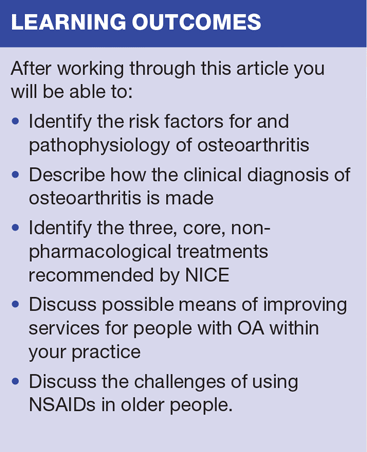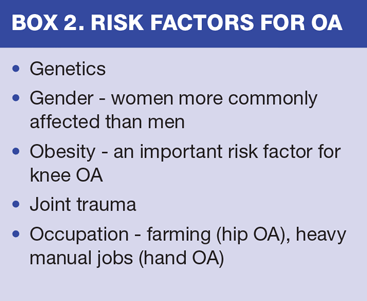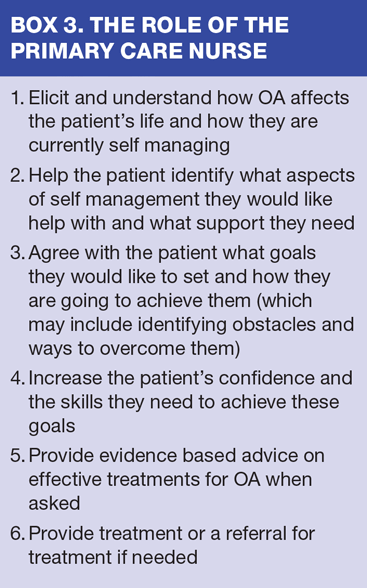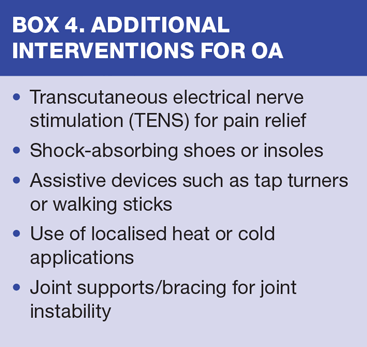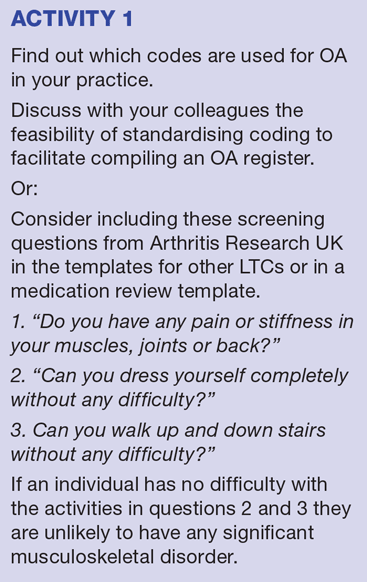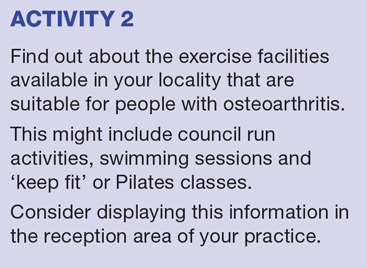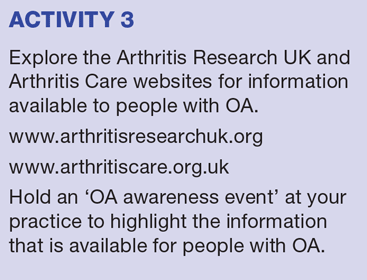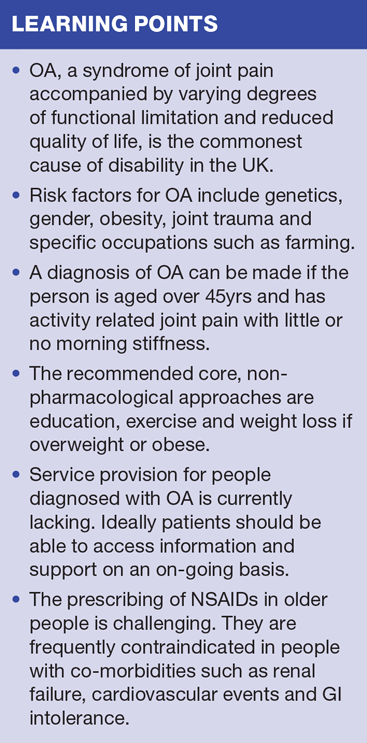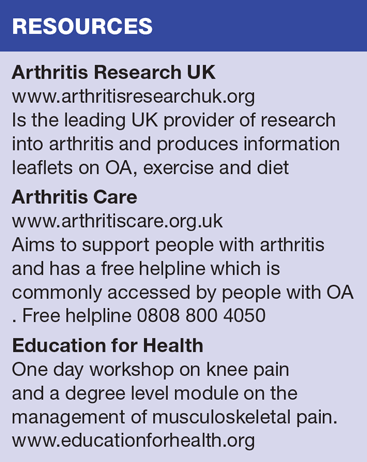The challenge of managing osteoarthritis in primary care
Sarah Ryan
Sarah Ryan
RCN, PhD, MSc, FRCN
Nurse Consultant Rheumatology Staffordshire and Stoke on Trent Partnership Trust, Honorary Senior Clinical Lecturer, School of Nursing and Midwifery,
Keele University
Practice nurses are ideally placed to help people with osteoarthritis engage in the self-management that can reduce its impact
Osteoarthritis (OA) is a common condition and the biggest cause of disability in the UK. The mainstay of management involves education, exercise, pain management and, where required, weight reduction. Appropriate information and support can enable patients to manage their symptoms effectively.
Following diagnosis of OA, however, there is currently a lack of service provision for this patient group, despite the large number of people living with the condition. Primary care nurses are ideally placed to provide the information and support that these individuals need and want.
This article focuses on the management of OA and discusses your potential role in caring for patients with this condition.
PREVALENCE
There are currently around 8.5 million people with OA in the UK,1 three quarters of whom live in constant pain, and its prevalence is increasing as the population ages and obesity becomes more common.2
The prevalence of OA is similar to that of diabetes, yet it is not managed in the same systematic way. It is suggested that the management of musculoskeletal diseases should be multidisciplinary, structured around the patient journey and defined as an integrated care pathway,3 yet one of the current, significant deficiencies in care is the absence of services or access to care for people with OA.4 A challenge for primary care is to determine how to provide care for this common condition that, for those living with symptomatic OA, can have a major impact on everyday life.
PATHOPHYSIOLOGY
Osteoarthritis causes localised loss of cartilage, remodelling of adjacent bone and associated inflammation. It commonly affects the joints of the hands, hips, knees, shoulders and spine.
NICE guidelines define OA as a syndrome of ‘….joint pain accompanied by varying degrees of functional limitation and reduced quality of life.’5
It is often described as ‘wear and tear’ but OA would appear to be a metabolically active process that is characterised by periods of increased symptoms (referred to as a flare) followed by periods where symptoms become less bothersome. It seems that, in some individuals, there can be an element of repair so that minimal or no symptoms are experienced. Other individuals seem to have ongoing symptoms arising from a compromised repair process. Risk factors and the common symptoms of OA are shown in Boxes 1 and 2.
DIAGNOSIS
The diagnosis of OA can be made clinically if a person:
- Is 45 years or older, and
- Has activity-related pain, and
- Has either no morning stiffness or morning stiffness that lasts no more than 30 minutes.
(Inflammatory joint diseases, such as rheumatoid arthritis, are characterised by prolonged morning stiffness.6)
X-Ray
For the majority of people an x-ray is unnecessary and the diagnosis can be made on clinical grounds. In addition, symptoms often do not correlate with X-ray findings; in clinical practice it is common to see patients with severe pain who have minimal X-ray changes and, conversely, patients who are asymptomatic with aggressive radiological changes. It can, however, be helpful to X-ray the knee and the hip when there is diagnostic uncertainty about the cause of the pain, for example if OA hip is suspected as the cause of knee pain,7 and when referring a patient to an orthopaedic surgeon for a surgical opinion.
The characteristic changes seen on a plain X-ray are joint space narrowing (due to cartilage loss), marginal osteophytes or ‘spur formation’ and subchondral sclerosis of the bone.
RECOMMENDATIONS AND ACTUAL SERVICE PROVISION
NICE recommends that at the time of diagnosis an holistic assessment of the impact of OA on the individual’s daily life should be undertaken. This should include:
- An assessment of pain, mobility, work and social role
- Effect on mood and sleep, and
- An exploration of how the individual is coping.5
In reality, after diagnosis, patients are often discharged from services they have they been referred to and, if ‘discharged’, left with the impression that there is no treatment or help available.3 What patients with OA want from their healthcare services is access to nurses and other health professionals (including physiotherapists and occupational therapists) able to offer a range of pain interventions, including medication, exercise and relaxation. They also want access to healthcare professionals who can provide information about the condition (including diet, exercise and aids) and access to primary care OA specialists to support self-management.3,8 People with OA would also like to access care at a time when their symptoms were heightened. These aims are supported by NICE but it seems that current care provision does not always offer these opportunities.3,5
A major barrier to improving care is the lack of inclusion of OA in QOF. We therefore need to look at other opportunities to engage with people with OA without creating new services. Many people with OA also have another long-term condition (LTC), and if they are taking analgesics regularly, they will need to be seen for a medication review. These consultations could provide you with an opportunity to enquire how they coping with their OA and point them in the direction of appropriate support – in the voluntary sector, e.g. Arthritis Research UK or Arthritis Care, if necessary. (See Resources) Arthritis Research UK has developed some quick screening questions that can be used to identify individuals suffering from significant musculoskeletal disease. (See Activity 1)
Many of you will already have considerable experience and expertise in helping people with LTCs engage in self management, including providing advice on exercise. The skills you already have should be transferrable to supporting people with OA and further training is now available.(See Resources)
MANAGEMENT
The aim of treatment is to reduce joint pain and stiffness, maintain and improve joint mobility to maximise quality of life, and limit the progression of joint damage.9
As well as appropriate pharmacological approaches to pain management, three, core, non-pharmacological treatments are recommended by NICE, including:
- Education, advice and access to information about OA
- Exercise (including strengthening exercise and aerobic fitness training)
- Weight loss if overweight or obese.5
Primary care nurses are well placed to support patients with these non-pharmacological approaches. They are often expert in supporting patients with long term conditions such as diabetes and asthma, where the needs for self-management have many similarities. Following a training programme as part of a research project, ten primary care nurses have been successfully running clinics to support patients with OA to develop self management techniques based on these core, non-pharmacological recommendations from NICE. 5
Education and access to information
The main myth to dispel is that OA is a progressive wearing out of joints due to old age, which invariably leads to a reduction in activity. Practice nurses can have a key role in explaining what OA is and how patients can play an active role in managing their symptoms. (Box 3). It is important to convey positive and constructive messages about OA and its progression. Many people believe that nothing can be done and that progression is inevitable.
Although OA is not curable, there are many options that can be explored to help manage the symptoms and it is important to share this message with patients. Ideally patients should be able to access information on an on-going basis. If the practice is unable to address this need then the patient should be informed of a national patient telephone helpline where advice can be obtained. (See resources)
Exercise
There is good evidence that both general aerobic exercise (such as walking and swimming) and local muscle strengthening exercises (especially quadriceps exercises for knee OA) can reduce pain, disability and impaired proprioception, while improving balance, wellbeing, sleep quality and joint function.11 Manipulation and stretching exercises can also be beneficial for hip OA.
Patients can be fearful that exercise will increase pain and/or damage the joint. They need information and reassurance that this is not the case. It can also be useful to engage the patient in goal setting and, in partnership with them, help them decide on a specific and realistic goal, such as a 10 minute walk, twice a week on set days.
Basic, motivational interviewing techniques are invaluable when helping a patient to set a realistic goal. You will need to establish:
a) How confident they feel in undertaking and achieving the goal, and
b) How important the goal is to them.
Both these aspects can be assessed on a scale of 1–10. Ask the patient how confident they are that they can achieve this goal, with 1 being ‘not confident’ and 10 being ‘very confident’. Use a similar scoring system to ask the patient to assess how important the goal is (1 being ‘not important’ and 10 being ‘very important’). If they score less than 7 in either of these domains they are unlikely to attain the goal. In this situation you will need to explore with the patient what would need to occur for the rating to be increased to over 7 and should also question whether this is the right goal for them at this time.
Weight Management
Even a modest increase in BMI within the normal range significantly increases the risk of developing OA of the knee. OA progresses more rapidly in obese people and increases the need for joint replacements.
In a study of 316 people with knee OA who were obese or overweight, patients randomised to the diet and exercise group, who lost weight and increased their level of physical fitness reported greatest improvements in pain and disability. Each pound of weight loss resulted in a 4-fold reduction in the load exerted on the knee per step per day.12 Patients often feel that they are in a vicious, downward spiral: they can’t exercise because of the pain so they start to put on weight which makes exercise more difficult and more painful. In this situation support and monitoring, with access to organisations such as Weight Watchers for some, is often the most effective way to help people address their weight.
Additional, non-pharmacological interventions for the management of OA are shown in Box 4.
Pharmacological management
nPeople with OA perceive pain as having the greatest detriment on their quality of life.13 However, patients are often reluctant to take analgesics. Time is well spent eliciting their beliefs about medicine (such as addiction) and educating and reassuring them about how analgesia can be used in a positive way, such as before exercise to ensure that the activity is more comfortable to undertake, or when the OA is symptomatic.
Paracetamol and topical non steroidal anti inflammatory drugs (NSAIDS) are recommended as first line pharmacological treatment although there is growing evidence that paracetamol is not as effective or as safe as first thought.14,15 The addition of opioid analgesia should be considered, bearing in mind the risks and benefits for older people.5 NICE guidance on the use of paracetamol is likely to be updated when the current MHRA review of the safety of OTC analgesics is completed.
Topical NSAIDs and capsaicin are effective for knee or hand OA but users of topical capsaicin should be advised not to take a bath in hot water after use as this can lead to an uncomfortable burning sensation.
Oral NSAIDs (including Cox 2 inhibitors) can be considered for those patients who do not obtain sufficient relief from paracetamol and/or NSAID gels, but it is worth bearing in mind that there is very little data on the use of drug treatment in people with OA over 70 years. NSAIDs are frequently contraindicated in older people with co-morbidities such as renal failure, cardiovascular disease, diabetes and gastro-intestinal intolerance. If an NSAID is required then it should be prescribed in the lowest effective dose for the shortest period of time and with concomitant prescription of a proton pump inhibitor.
Intra-articular steroid injections can be used to provide quick, effective short-term relief from pain.
There are limitations to the published evidence on treating OA. Most of the studies have focused on OA of the knee and are of short duration, involving one intervention. In clinical practice patients often have more than one joint involved and this may alter the effectiveness of the intervention.
Arthroplasty
Surgery should be offered before functional limitations and severe pain occurs.5 It should be offered irrespective of age, gender, lifestyle or the presence of co-morbidity and the decision for referral should be made by the person with OA, their clinician and the surgeon.
CONCLUSION
There are many interventions that can help people living with OA manage their symptoms effectively. Practice nurses are ideally placed to provide the information, support and guidance on self-management that patients want. The challenge facing primary care is to identify how patients can access the information and services they need to manage their condition.
REFERENCES
1. Arthritis Research UK. Understanding arthritis: a parliamentary guide to musculoskeletal health. Arthritis and Musculoskeletal Alliance. 2012
http://arma.uk.net/wp-content/uploads/pdfs/Arthritis-Research-UK-Sep2012-Understanding-Arthritis.pdf
2. ARMA. Standards of care for people with osteoarthritis. Arthritis and Musculoskeletal Alliance 2004: London
3. DoH. The Musculoskeletal Services Framework: A joint responsibility, doing it differently. 2006: HMSO, London
4. Ryan S, Lillie K, Thwaites C, Adams J. What I want clinicians to know - experiences of people with arthritis. British Journal of Nursing 2013; 22(14):808-812
5. National Institute for Health and Care Excellence. Osteoarthritis: care management in adults.CG177 issued February 2014
6. Ryan S. Rheumatoid arthritis: how to diagnose and manage the condition. Practice Nurse 2014;44(6):36-40. Available at: http://www.practicenurse.co.uk/index.php?page=14&id=916&cat=23
7. Porcheret M, Healey E, Dziedzic K, Corp N. Osteoarthritis: a modern approach to diagnosis and management. Hands on, reports on rheumatic diseases 2011; series 6, autumn 2011
8. Mann C, Gooberman-Hill R. Healthcare provision for osteoarthritis: concordance with what patients would like and what health professionals think they should have. Arthritis Care Research 2011; 63 (7):968-72
9. Zhand W, Moskowitz RW, Nuki G et al. OARSI recommendations for the management of hip and knee osteoarthritis part 1: critical appraisal of existing treatment guidelines and systematic review of current research evidence. Osteoarthritis Cartilage 2007; 15(9):981-1000
10. Healey E, Ryan S, McHugh G et al. Development of a model consultation and training package for practice nurses to support self management of patients consulting with OA in primary care. Rheumatology 2013; 52(Supplement 1):028
11. Byers Kraus V, Doherty M. Osteoarthritis. In Adebajo A, ABC of Rheumatology 2010. Blackwell Publishing Limited.
12. Messier SP, Gutekunst DJ, Davis C, DeVita P. Weight loss reduces knee-joint loss in overweight and obese older adults with knee OA. Arthritis Rheumatism 2005;52:2026-32
13. Healey JH, Tyler WK. The role of orthopaedic surgery in the palliative care of people with cancer. In Hanks G, Cherney NI, Christakus NA et al (eds) The Oxford Textbook of Palliative Medicine. Forth Edition, Oxford: 958-972
14. Doherty M, Hawkey C. Goulder M et al. A randomised controlled trial of ibuprofen, paracetamol or a combination tablet of ibuprofen/paracetamol in community-derived people with knee pain. Annals of Rheumatic Diseases 2011; 70:1534-1541
15. García Rodríguez LA, Hernández-Díaz S. The risk of upper gastrointestinal complication associated with nonsteroidal anti-inflammatory drugs, glucocorticoids, acetaminophen, and combinations of these agents. Arthritis Research and Therapy 2000; 3(2):98-101
Related articles
View all Articles
